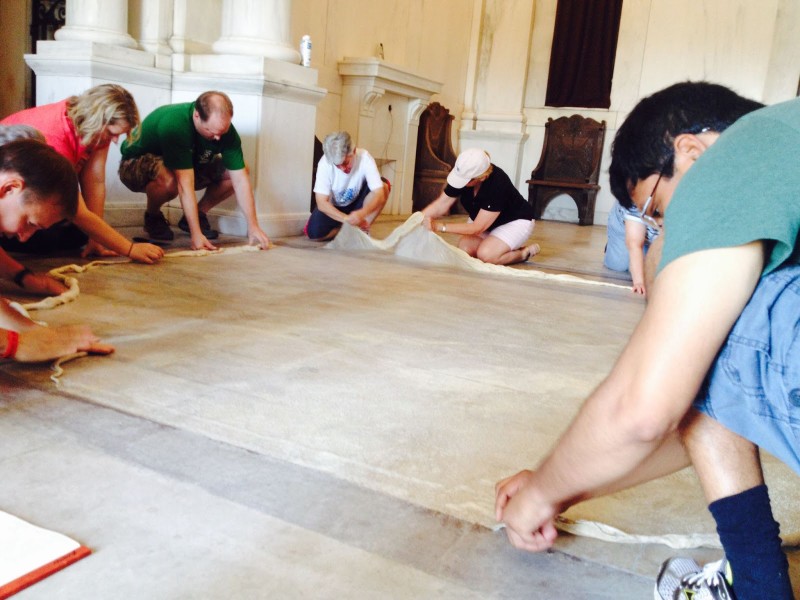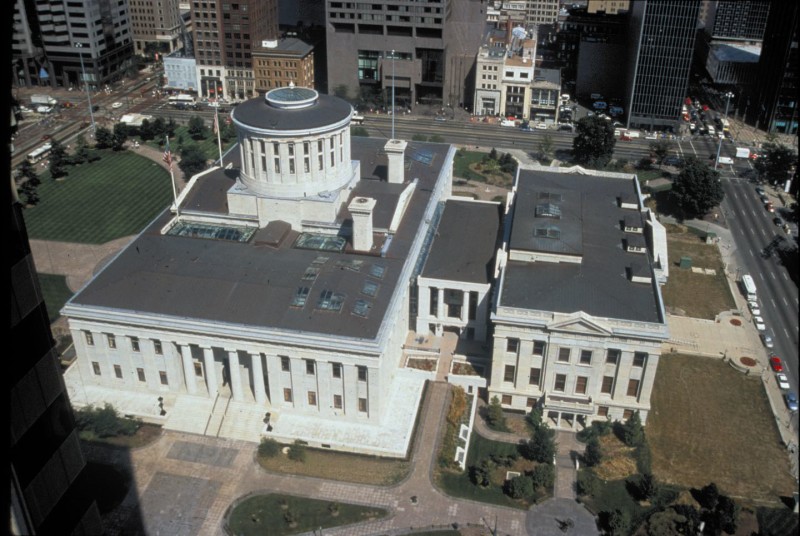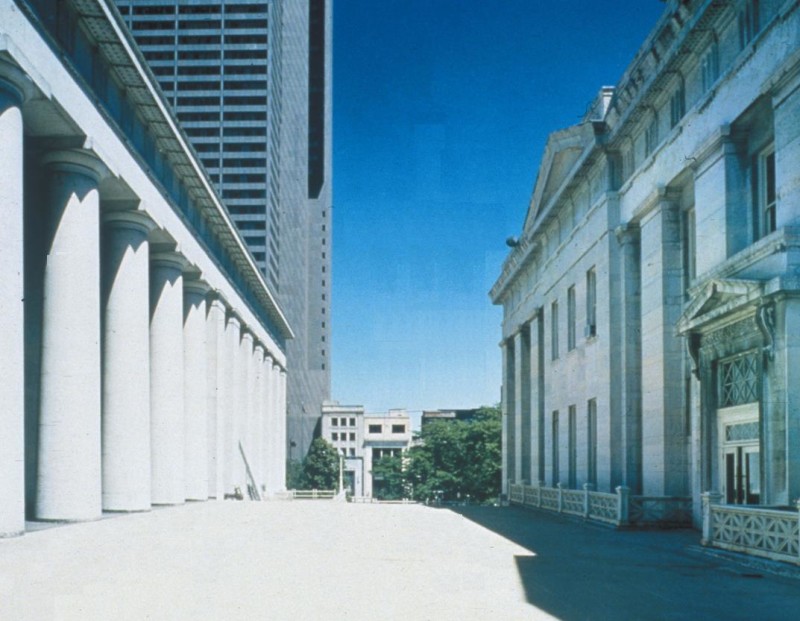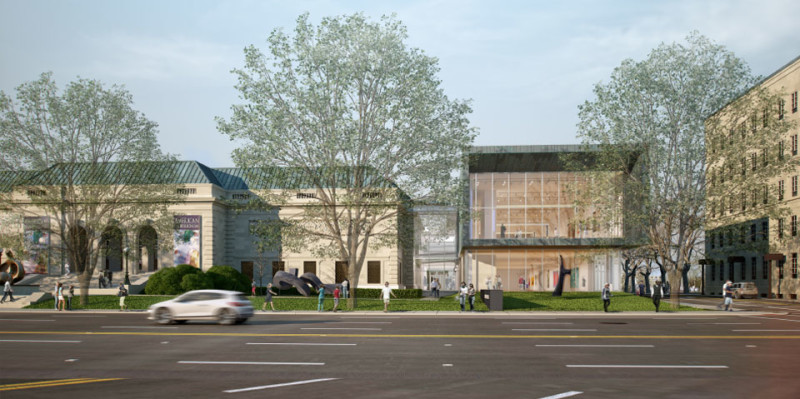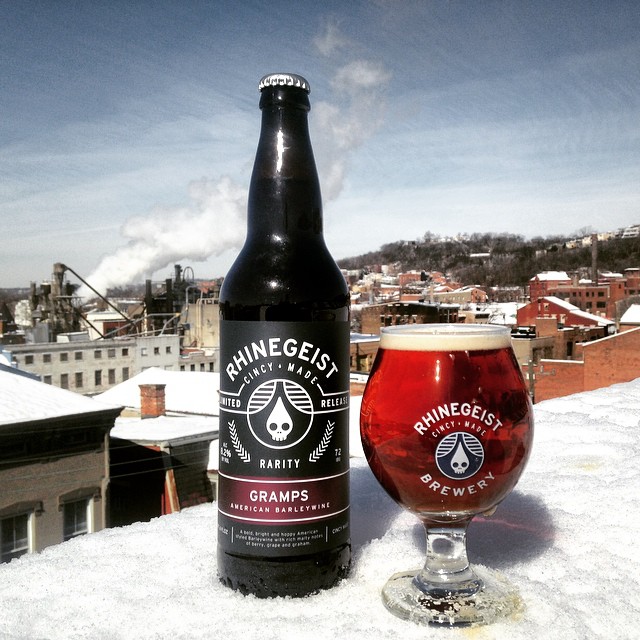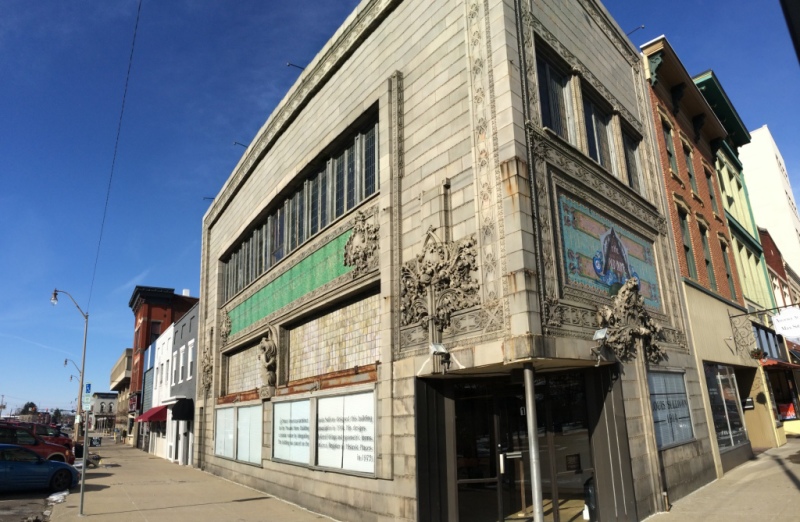YOP Land Grant Brewery Tour and Happy Hour
The Young Ohio Preservationists are hosting an exclusive tour and presentation by Blake Compton, CEO of Compton Construction, LLC about the making of Land-Grant Brewing Company!
The space had previously been an elevator factory prior to the change of use renovation. The building was transformed from top to bottom into what has become a destination brewery in Franklinton. The building now features reclaimed materials, including locally harvested barn wood, along with custom features that make it a one of a kind space.
Join us for drinks at the brewery following the tour!
![]()
Wonderful Wood Windows!
Here in central Ohio we’ve had our first real blast of winter over the last couple of days…snow flurries, temperatures in the 20s, teeth-chattering winds, the whole nine yards. And, if you live in an old house with wood windows (like I do), you’ve likely felt that wintry reminder when passing by one of those windows.
So, maybe it was just a wintertime coincidence (or destiny) that one of the first emails from a concerned Ohioan to Heritage Ohio in 2016 brought a plea for help, requesting assistance to convince the owner of a historic building not to dump their original wood windows.
As you can imagine, this is one of the most common email discussion roads we go down. Too often, this is what we find: building owners ready to toss their original sash because they don’t function. The sash are painted shut; the sash, if opened, don’t stay up (the sash cords broke long ago); or, as in my case, when you walk by the window in the dead of winter, you can feel the breeze inside the building. In that case, weatherstripping is the issue.
While solving any of these window issues isn’t especially difficult, too often, the owner freezes once that thought, “the hassle of repair,” goes through their mind, and they reach for their tablet to google “window replacement.”
There has been a lot of marketing from the replacement window industry extolling the virtue of replacement windows. When it comes to windows, we’ve gone through a good 40 years of purging the word “maintenance” from our collective consciousness, while the window replacement industry has trained people to believe that the “hassle” of repair is a fate worse than death.
To counter this, we preservationists have begun promoting the value of preserving original windows with groups such as the Window Preservation Alliance. And the National Trust has recently put a greater focus on quantifying the value of wood windows, why preserve, and how best to preserve. Their report, Saving Windows, Saving Money, has been especially helpful for us. The report quantifies the energy savings, cost, and return on investment for a variety of window treatments, including weatherstripping, installing an exterior storm, and installing a new high performance replacement window. And guess what they found? DIY weatherstripping offers an average 31% return on investment, while DIY high performance replacement windows offer a 3% return on investment.
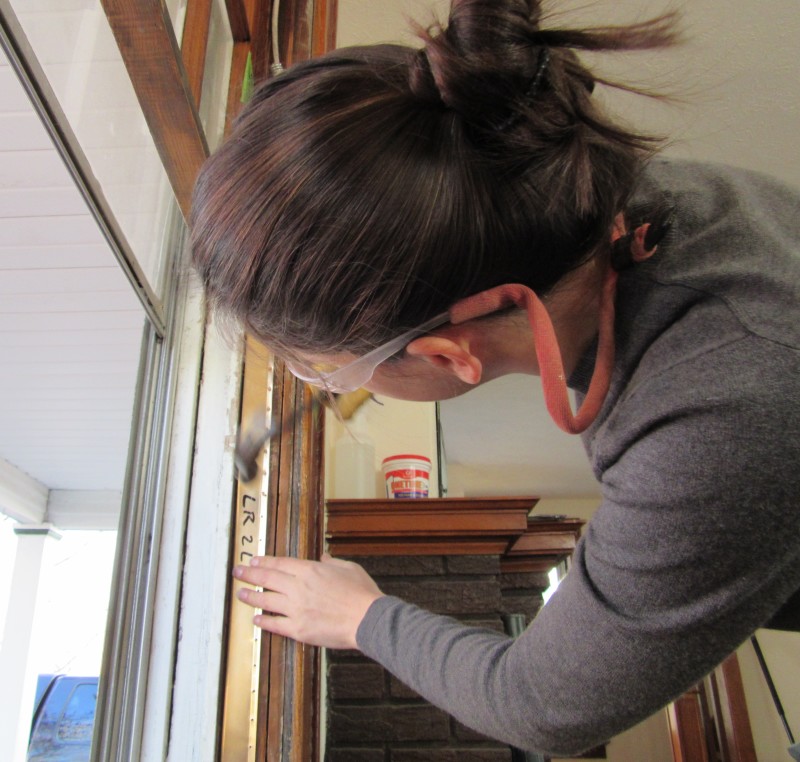
That shiny stuff Rebecca Torsell is nailing onto the jamb may be bronze, but when it comes to energy efficiency, it’s worth its weatherstripping weight in gold.
And this is exactly why YOP offering their hands-on window repair training last year in Columbus was so valuable: giving homeowners the skills to tackle DIY projects such as window repair and weatherstripping SAVES MONEY, while saving the architectural integrity of their homes, while saving money on the heating bill.
Now if only we had the billion dollar marketing budget to get THAT message out!
![]()
Holiday Gift Ideas for the Preservationist
The downtown main streets are covered in lights and there are wreaths on all the historic houses, which means it’s that time of year when you’re trying to find the perfect gift for the preservationist in your life. What do you get for that nerd who has such specific tastes? Here’s a handy guide to give you some ideas for the holiday season!
Olloclip
Olloclips are clip-on lenses for your iPhone that give you a 4-in-1 option per kit. Perfect for your preservationist who spies a gorgeous building while out on a jaunt and needs to snap a high-quality photo for their Instagram.
Coonley Tumblers
Your preservationist can enjoy his or her favorite beverage in these glass tumblers that have beautiful detailing from the Avery Coonley Playhouse triptych in Riverside, Illinois.
Gift Membership to the National Trust
Give a gift membership to the National Trust for Historic Preservation and your preservationist will receive discounts for accommodation and admission to National Trust sites worldwide. He or she loves discounts!
Aminimal Studio GPS Jewelry
Using GPS information from OpenStreetMap, Brooklyn-based Aminimal Studio has created a line of urban jewelry and dog tags of urban grids from around the world to help your preservationist look stylish.
Red Rabbit Republic Prints
Help your preservationist decorate their place with these beautiful prints from Etsy seller Red Rabbit Republic. They’re printed on fibre-based 285gsm Hahnemuhle Torchon – an acid-free, archival fine art paper of museum standard that lasts for centuries.
Happy shopping and happy holidays from the Young Ohio Preservationists!
Article by Nimisha Bhat
![]()
YOP Green Lawn Abbey Marble Cleaning Workshop Recap

YOP members (left to right) Sarah Marsom, Nimisha Bhat, Kalpa Baghasingh, Pearl-Jean Mabe, & Michael Blau.
Built in 1927 by the Columbus Mausoleum Company, Green Lawn Abbey is a neoclassical mausoleum listed in the National Register of Historic Places and has been undergoing a restoration for a number of years. With 1½“ thick granite walls, marble interior and an imported tile roof, it still impresses with its regal structure and beautiful stained windows. Over the years, the Abbey’s foyer floors have accumulated large areas of badly stained marble from years of organic and metallic damage.
Enter Community Partnership Grants Coordinator for the City of Columbus and fearless leader Kate Matheny. Kate has dedicated herself to restoring Green Lawn Abbey to make it into a usable space for programming, and successfully acquired CLG grants and other opportunities to preserve this historic structure. The Young Ohio Preservationists worked with the Green Lawn Abbey Preservation Association to coordinate a workshop in order to learn about and do some hands-on marble cleaning on July 25th. Kate, her husband Tom of Schooley Caldwell Associates, and Matt Wolf of the Centennial Preservation Group kicked the workshop off by giving a history of the building and its structure. The workshop volunteers learned about different types of marble, how the Abbey’s preservation management plan was created, and the basic process behind marble restoration.
After surveying the test area set aside for cleaning, volunteers got a brief explanation from Matt about the type of poultice being used on the marble. The poultice, once applied, thickens over time and basically pulls up stains and dirt from the marble. The poultice had been applied a little over 24 hours prior to the workshop, and no one quite knew what the results would be. Workshop volunteers then rolled their sleeves up and got to work, removing the poultice as a team by peeling it back slowly. Wet rags and water were then used as an additional measure to remove any remaining dirt that had been brought up by the poultice.
Volunteers discovered a 75% improvement after all the cleaning efforts, and it was decided that the marble would look shiny and new after a few more applications of the poultice and a little more elbow grease!
To become involved in future restoration events at Green Lawn Abbey, keep an eye out on the Green Lawn Abbey website and their Facebook page.
For more pictures check out the album on YOP’s Facebook page
Article by Nimisha Bhat
![]()
Preservation Month Photo Contest | And the winner is…
Thank you to everyone who voted this year, and congratulations to Judith Khaner, this year’s winner!
Judith’s winning image features the interior of the Arcade, a Cleveland landmark revitalized for shops and hotel use in the early 2000s. As this year’s winner, Judith’s image will be featured on a future issue of Revitalize Ohio.
Whether entering our contest or voting for a winning entry, we hope you’ll join us next year for Preservation Month for our 2016 Photo Contest.
Here’s Judith’s winning entry:
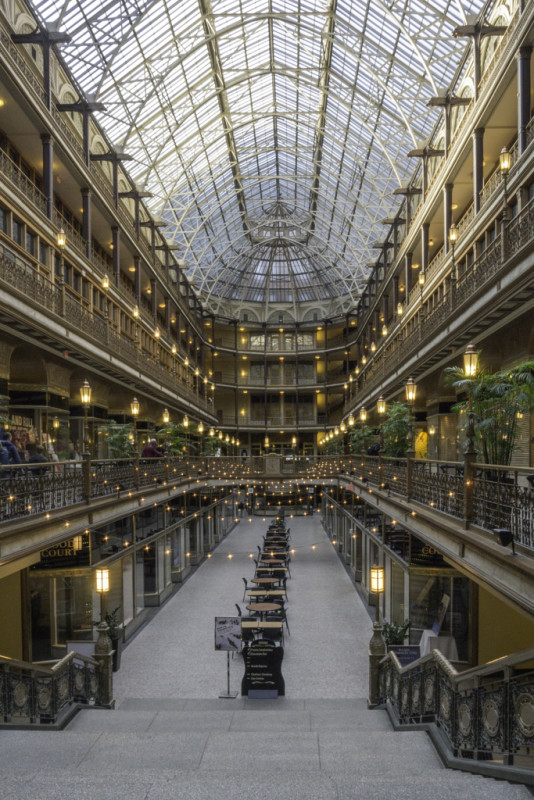
Sensitive Additions To Historic Buildings: A Primer
By: Kalpa Baghasingh
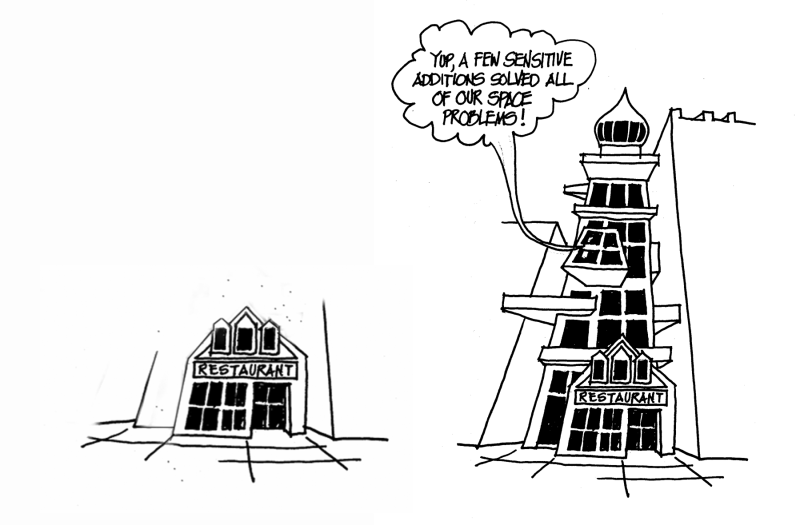
Sketch by: Jeff Gordon, AIA, Former Director of Design at Schooley Caldwell Associates, drawn for Sympathetic Additions to Historic Buildings, 2012 AIA lecture, by Robert Loversidge, FAIA, President and CEO, Schooley Caldwell Associates
Additions are one of the trickiest aspects of working with a historic building. Additions are often required for programmatic reasons. The National Park Service (the agency that develops historic preservation policy and guidance on preserving and rehabilitating historic buildings) advises that “an exterior addition should be considered once it has been determined that the new program requirements cannot be met within the existing building envelope.” Sometimes the available square footage and configuration of spaces do not meet the needs of a proposed use, and sometimes an addition is warranted to account for expansion of the current use. Many times, an addition helps in extending the life of a historic building, which would otherwise have been in danger of being abandoned or demolished for being infeasible of supporting modern uses.
Additions can be as small as an entry vestibule, or as large as entire buildings. In any case, designing an addition is a delicate balancing act–the addition should be compatible with the historic building, but should also be distinguished enough so as not to offer a false impression of being historic. In a nutshell, respect the historic building, but don’t try to pass off an addition as old. It’s no wonder then that an addition often invites opposing design philosophies and controversy.
So, what is a “sensitive” addition? The National Park Service (NPS) has published guidelines, which strives to answer this very question, and provides a sort of checklist to help achieve it:
- A new addition should be simple and unobtrusive in design, and should be distinguished from the historic building in a manner that makes clear what is historic and what is new.
- A new addition should be constructed in a way that there is the least possible loss of historic materials and so that character-defining features are not obscured, damaged, or destroyed.
- A new addition should not be highly visible from the public right of way; a rear or other secondary elevation is usually the best location for a new addition.
- The construction materials and the color of the new addition should be harmonious with the historic building materials.
- The new addition should be smaller than the historic building—it should be subordinate in both size and design to the historic building.
You can read the entire Preservation Brief #14 here.
Let’s look at a couple local examples now. The first example is a classical addition at the Ohio Statehouse, and the second one is a more modern addition at the Columbus Museum of Art.
Ohio Capitol Atrium Connector
Architect: Schooley Caldwell Associates
The Ohio Capitol Atrium was added as a connector between the Ohio Statehouse (1838-1861) and the Senate building (1899-1901) in 1993. The space was a walkway between the two buildings, and is now used as a space for conferences and special events. The addition is compatible with the neoclassical style of architecture of the Statehouse. The façade is set back from the front, and the scale is subordinate to the parent buildings. The addition looks different enough to not be confused with the historic buildings
You can read a brief history of the Connector here
Columbus Museum of Art Expansion
Architect: Design Group
This ongoing expansion project at the Columbus Museum of Art has an interesting bold design as its addition. Its minimalistic yet soaring design contrasts with the historic building, but also borrows from it. The pre-patinated copper and limestone façade has clearly been inspired by the historic building. The two-story addition is tied to the historic 1931 museum building by a recessed glass connector, which protects the integrity of the original building. This definitely pushes the boundaries of conventional “rules” regarding sensitive additions, but also emphasizes the fact that there is no one right answer when it comes to sensitive additions.
You can read more about the expansion project here:
In summary, a sensitive addition should strive to:
- Preserve the historic character and integrity of the property.
- Preserve significant historic materials and features.
- Protect the historical significance by making a visual distinction between old and new.
- Be compatible to the historic scale, mass and form.
- Be reversible.
So, the next time you come across a historic building, try figuring out if it was added on to. Or if you are looking to construct an addition to your vintage house, consider these guidelines before moving ahead.
Preservation + Pints (Or Shots)
By Sarah Marsom
Craft breweries and distilleries have swept Ohio by storm. Many breweries are hoping to revitalize the state’s history as a beer capital, and many distilleries are using historical beverages to inspire their contemporary palates. Here are a few places you should try!
Elevator Brewery and Draught Haus (Columbus)—both a popular bar and eye catching building in Columbus. Elevator Brewery’s history dates back to 1897. Located in the Bott Brothers’ Billiards building, this contemporary bar thrives on its historical elements—the billiards tables from the 1800s, stained glass entry, tile floors, decorative ceilings, and a well preserved bar. The Elevator Brewery and Draught Haus is listed in the National Register of Historic Places as part of the Columbia Building. You can go to www.elevatorbrewing.com for more information.
Rhinegeist (Cincinnati)—Rhinegeist means “ghost of the Rhine”, and bringing a ghost back to life is exactly what this beer company did! Located in the historic Over-the-Rhine brewery district, Rhinegeist is revitalizing the beer industry, which made the area thrive in the late 1800s. Prohibition put 38 breweries out of business and left countless German immigrants unemployed. In the recent past, developers have been revitalizing the Over-the-Rhine neighborhood; Rhinegeist has sparked new life into Christian Moerling Brewing Company’s old bottling plant. Want to learn more about the building’s history and Rhinegeist? Take one of their guided tours. You can learn more at www.rhinegeist.com.
*Cincinnati is also home to underground brewery tours! This town’s beer history is deep!
Homestead Beer Co (Licking County)—while the brewery is not in a historic building, Homestead Beer Co has its headquarters in the very historic community of Granville, and the name evokes wonderment of the original farm settlements, which created a thriving Licking County in the 1800s. Homestead Brewing does not use modern yeast strains, instead preferring yeast which could have been used by grandfathers of the past to brew. With brew names such as 1805, Five Points Irish, and Barnraiser, one knows the people behind Homestead use the past as inspiration to create contemporary drinks. Go to www.homesteadbeerco.com to learn more.
E.S. Distillery (outside Fremont)—located in a 120-year-old barn, the Ernesto Scarano distillery is worth a visit. This craft distillery is supposedly the smallest legal whiskey distillery in America. Www.esdistillery.com for more information.
What are some of your favorite bars, breweries, or distilleries in Ohio with historic elements? Add your favorites to the list in the comments section below.
A sneak peek into what YOP is planning
We’re excited to start a new blog series this month, with preservation perspectives written by Young Ohio Preservationist members. Sarah Marsom, the YOP chair, kicks off the series this month.
The Young Ohio Preservationists are new to the scene and excited for 2015. We have already hosted a successful tour of the Cristo Rey Columbus High School, which was an exciting multi-million dollar tax credit project, and we had an engaging window restoration workshop, where we fixed all of the historic windows in a Dutch Colonial home in the Westgate neighborhood of Columbus.
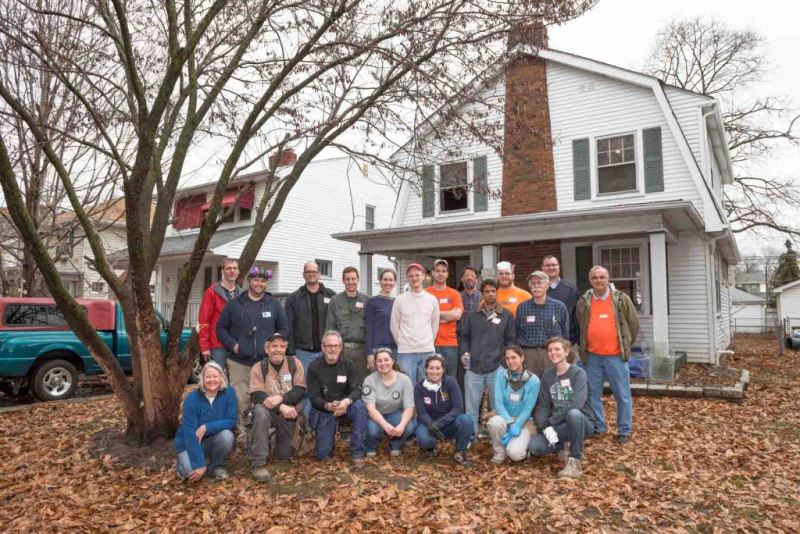
Attendees of the windows workshop gather outside the Westgate home. Photo courtesy of Stephen Newport.
It is the Young Ohio Preservationists board’s goal to provide unique experiences to both recreational and professional preservationists. And if you are wondering if you are too old to participate, do not worry! We invite people of all ages to engage with us.
Throughout the year we will be rolling out exclusive events, but here is a sneak peek for two experiences you cannot miss out on!
On April 25, the Young Ohio Preservationists are taking Newark by storm. The Licking County Foundation has invited us to tour the Louis Sullivan designed Home Building Association Bank, and they are coordinating some bonus historic building tours exclusively for the YOPs! Following the tours, we will be hosting a design charrette and helping the foundation brainstorm the best adaptive use opportunities for the Sullivan designed bank.
As part of the Green Lawn Abbey CLG grant, the YOPs will be hosting a marble cleaning workshop. Green Lawn Abbey is a 1927 neoclassical mausoleum listed in the National Register of Historic Places and has been undergoing a restoration for a number of years. The Centennial Preservation Group will teach participants the best practices for marble cleaning. Our assistance will bring Green Lawn Abbey one step closer to renting the space for events and creating a sustainable income source for maintenance.
Make sure to follow us on Facebook, Instagram, or join our mailing list by emailing yop@heritageohio.org to make sure you know about our events!
![]()
Young Ohio Preservationists
Update 3/1/2016: The Young Ohio Preservationists have become a reality and are located at youngohiopreservationists.org!
One of my absolute favorite blogs is Preservation in Pink, so I found her post a few weeks back about young preservationists especially interesting. As you may be aware, Heritage Ohio has been active in working to help build a Young Ohio Preservationist movement, from developing a survey to get feedback about how 20-40 year old self-identified preservationists view themselves shaping preservation in Ohio, to holding one-on-one stakeholder interviews, to holding introductory planning meetings in Columbus this past January.
As the PiP author expresses in her blog post, preservationists in leadership positions have done a better job in recent years of actively engaging people under 40 to help shape the preservation movement. Although some bristle at the notion that a “Young Preservationist” appellation is even needed, preferring instead to seamlessly mesh with the rest of the preservation world, the concept of giving young preservationists special status within the preservation world has taken hold. A lot of Old Preservationists (myself included) are excited by the prospect of fresh ideas, and new ways of looking at (and saving) old buildings that young preservationists can bring to the table.
What do you think? Is there a place in the preservation world for groups of a specific age range?
![]()




